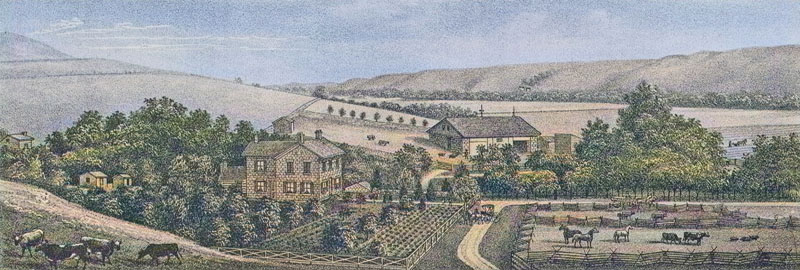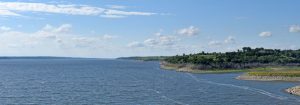
John Booth’s Residence in Garrison, Kansas by L.H. Everts & Co., 1887.
Garrison, Kansas, was a village in Green Township in the Blue River Valley of Pottawatomie County. It is a lost town today because it was destroyed in 1959 to create Tuttle Creek Dam and Reservoir.
Garrison was founded in 1879 along the shores of the Big Blue River. That year, the town was platted and named after C.K. Garrison, president of the Missouri Pacific Railroad.
A post office was established on March 10, 1880. Most of the early residents came from Indiana, Illinois, and Ohio. However, a few came from England, Germany, and Ireland. That year, Garrison had a population of 145, and the Leavenworth, Kansas, and Western Railroad ran right down the middle of its Main Street.
Railroads connected the towns in Blue Valley and the Flint Hills. In the 1880s, the Kansas Pacific Railroad ran along the western edge of the Big Blue River and connected Garrison with Randolph upriver and Manhattan downriver. The Kansas Pacific didn’t run through Garrison, as Garrison was on the east side of the Big Blue River, but it still connected with Garrison, where it and the Leavenworth, Kansas, and Western Railroad railroad crossed. The Leavenworth, Kansas, and Western Railroad came into Garrison from Olsburg to the east, passed through the heart of Garrison, and then ran west across the Big Blue River and on to Leonardville.
In 1885, the Winkler Brothers operated a mill powered by the Big Blue River, and Garrison was a station on the Kansas Pacific Railway. At that time, it had a Methodist Episcopal Church, a public school, a bank, three general stores, a lumber dealer, a saloon, a livery, a physician, a barber, a hardware store, a milliner, a wagonmaker, and a population of 400. Stagecoaches ran to Randolph and Manhattan daily. Livestock was its principal export.
By the 1890s, the town had reached its peak.
In 1908, the Union Pacific Railroad purchased the Leavenworth, Kansas, and Western Railroad.
In 1910, Garrison was on the Union Pacific Railroad. At that time, it had a money order post office with one rural route, express and telegraph offices, and a population of 160. Most of the population comprised farmers who raised livestock and grew wheat.
In 1935, the Kansas River once again flooded. Afterward, the U.S. Army Corps of Engineers recommended building seven dams and reservoirs throughout the Missouri River Basin, including Tuttle Creek. Though these flood control dams would protect residents and businesses and provide work for the hundreds of unemployed workers during the Great Depression, no money was appropriated.
In 1938, the U.S. Congress proposed building Tuttle Creek Reservoir again. In 1944, Congress authorized the Flood Control Act, which called for a series of large dams and levees on rivers in the basin, including Tuttle Creek. However, nothing was done.
The Blue River Valley was prone to flooding, and the government saw this as a significant cause of the Kansas River flooding. The Kansas River runs through Topeka, Kansas, and Kansas City, Kansas, major economic areas of the Midwest. The government wanted to protect these urban areas because of the economic damage, especially since the country was still recovering from the Great Depression.
Furthermore, the flooding of the Kansas River affected much more than the economics of these two cities. It also affected the possible flooding of the Missouri River, which flows into the Mississippi River, causing more flooding. These three rivers had so much farmland connected to them that it would also devastate the country’s food suppliers.
The government’s plan worried the Blue River Valley residents, who formed the Blue Valley Association as a collective voice to speak out against this plan. They wrote letters to congressmen and newspapers and researched alternatives to building the Tuttle Creek Dam. They also put together a document called “Keep Our Soil Home,” explaining ways to prevent flooding and combat the Corps of Engineers’ studies and plans.
In the summer of 1951, the people of Nebraska, Missouri, and Kansas experienced rains that caused significant flooding along the Mississippi, Missouri, and Kansas Rivers. The Republic and Big Blue Rivers also rose out of their banks. The cost of the flood in Kansas and Missouri was over $935 million.
Two years later, in 1953, another flood occurred, devastating Abilene, Kansas, home of new President Dwight D. Eisenhower. He soon authorized the Milford and Tuttle Creek dams to be built.
Construction of the Tuttle Creek dam began in 1952, and the government began acquiring the surrounding farmland. Although building the dam and reservoir would disrupt the lives of citizens in ten Kansas communities, without its protection, the potential damage during a flood to cities and towns downstream could amount to millions of acres of flooded cropland, transportation facilities paralyzed, and businesses destroyed.
Garrison’s post office closed on December 31, 1959. By July 1962, the town of Garrison in Pottawatomie County, Kansas, was completely submerged
The only thing left of Garrison today is the Carnahan-Garrison cemetery. Garrison was 15 miles west of Westmoreland, the county seat, and six miles from Olsburg.

Carnahan-Garrison Cemetery in Pottawatomie County, Kansas.
By Kathy Alexander/Legends of Kansas, updated November 2024.
Also See:
Big Dam Foolishness at Tuttle Creek Lake
Extinct Towns of Pottawatomie County
Tuttle Creek Lake and State Park
Sources:
Blackmar, Frank W.; Kansas: A Cyclopedia of State History, Vol I; Standard Publishing Company, Chicago, IL 1912.
Carnahan-Garrison Cemetery
Gent, Frank; The Town of Garrison, Chapman Center for Rural Studies, Kansas State University, Spring, 2011.
Polk’s 1884-1885 Official State Gazetteer and Business Directory of Kansas; R.L. Polk & Co., Detroit, MI.

